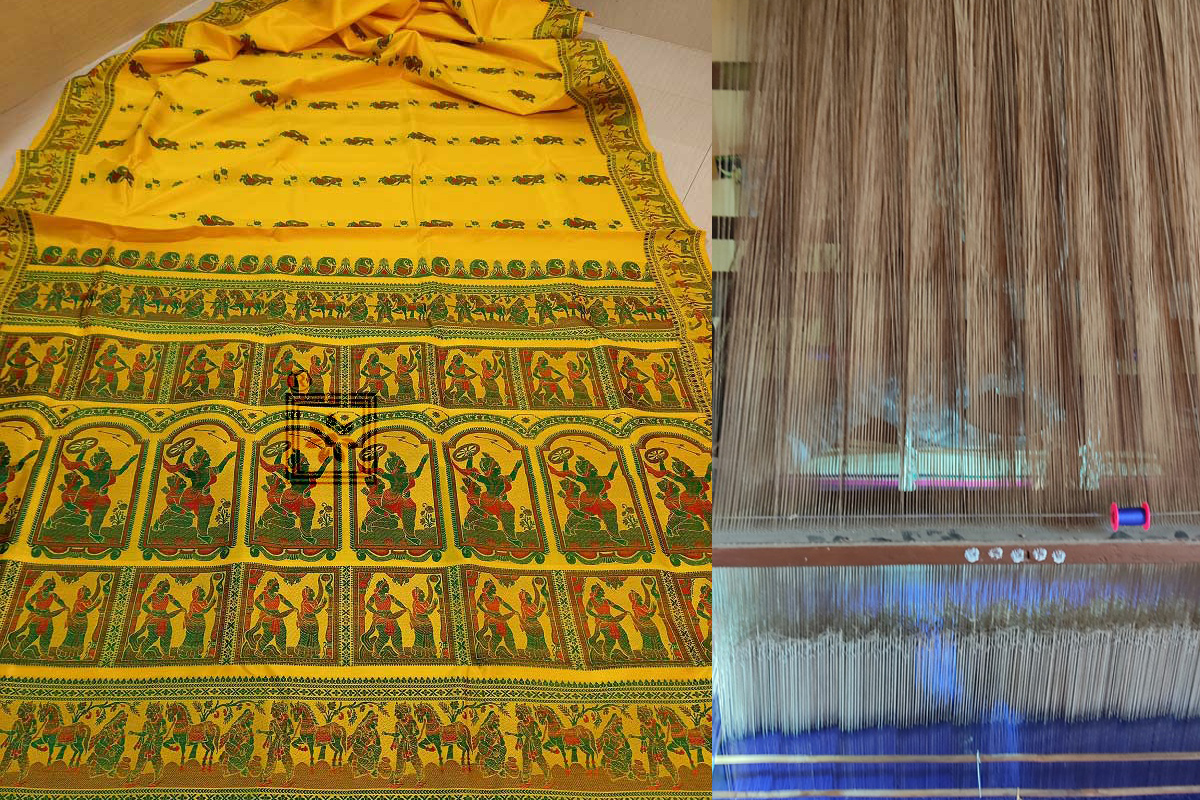Moving through the narrow lanes of Bishnupur, we arrived at the Barakalitala area.
A row of houses, overlooking a pond, stood with their doors opening onto the lane, and we could hear the active looms…khat-a-khat khat. The rhythmic beats created a unique sound, seemingly welcoming us. We hesitantly walked through the narrow lane to stop at a particular doorstep, on the instruction of a local friend. The door opened into a room where men were working skillfully at the looms—two, to be precise. This was the house cum workshop cum retail outlet of Manohar Rakshit, an award-winning master weaver of Bishnupur known for his exquisite Baluchari sarees.
The two men working on the looms sat in the pit, concentrating on weaving intricate designs. Overhead lamps focused on the loom at work. It was a fascinating sight to behold! Manohar Rakshit learned his craft from his father and grandfather. “Weaving has been our family tradition. Ever since I was a child, I watched my grandfather, father and uncles, and that’s how I learnt the art of weaving. It is in our blood. I hope that my children too will take up weaving, but now they are too young and are studying. My wife, too, has learnt the craft and often assists in weaving.” Though there are many women weavers, they do not, however, undertake to actually weave the sarees as it entails heavy physical labour and are mostly involved in assisting. Manohar Rakshit has about ten weavers working under him, producing, in a month, six to seven sarees. He operates from his workshop in Bankura and from his house in Bishnupur as a wholesaler, supplier and retailer.
Baluchari sarees derive their name from Baluchar village. Baluchari’s history can be traced back to 1704 CE, when Murshid Quli Khan, the first Nawab of Bengal, changed his capital from Dacca (now Dhaka) to Maksudabad (now Murshidabad). The Nawab’s artisans too shifted along with his court from Dacca and were given space to settle in Baluchar (now Jiaganj) village, and with them came the famous art of Baluchari weaving, which consisted of weaving elaborate themes depicting the lives of the Nawabs on silk sarees. Patronised by the Mughals, the art continued to flourish. But, then, flooding of the Bhagirathi River in the nineteenth century caused the Baluchari weaving trade to shift from Murshidabad to Bishnupur (Bankura district of West Bengal). Bankura, at this time, was under the reign of the Malla dynasty.
As per accounts, Baluchari lost its popularity during the Mughal and Malla eras. The craft saw a decline due to various socio-economic and political reasons, and most weavers were compelled to abandon their profession. Some of the reasons for the decline in the popularity of the craft can surely be linked to relocation, a lack of patrons, and the pressure of changing professions imposed on the weavers.
In spite of a temporary decline in its popularity, Baluchari weaving has, no doubt, set an example of how elaborate designs can also portray true elegance with bright threads and colours. Now protected by the Geographical Indication tag, Baluchari sarees remain a premium garment and hold the richness of Bengali history right within their folds. They are timeless classics.
Spread across the lanes and bylanes of Bishnupur, numerous weavers are at work, having inherited the skill from their forefathers. “There are a total of about 750 looms operating in Bishnupur,” informs Mantu Das of Kaniska, one of the most popular retail outlets for Baluchari in this town. His exquisite collection of Baluchari sarees is created by the gifted artisans who work on his 120 looms. “At our outlet, the Golap Baluchari has caught the buyers fancy,” says Das. “The Golap (rose) design was developed by the in-house designers of Biswa Bangla about four years ago, and since then we have been weaving them at our looms. This year, the Golap Baluchari is selling well.” As the name suggests, golap or rose motifs adorn the body, with intricately patterned borders highlighting the total effect. The hard labour that they put in every day helps create these woven classics. But alas! They remain faceless and nameless. Wish they too adopted Dubraj Das’s style of signing on their artworks.
Dubraj Das, the last known weaver of the Baluchar village (who died in 1903), would sign his sarees just as an artist, which was indeed a rare phenomenon for any weaver. There were other weavers too, such as Yajneshwar Kar, Baneswar Das, Goshta Bihari, Khudiram Biswas, and Goshna Kariokor, who used to sign their woven sarees. Some of Dubraj Das’s signed sarees are believed to be in private collections and at the Indian Museum in Kolkata.
After Dubraj Das’s demise, a master Nakshaband or maker of jalas, the fine craft of weaving Baluchari sarees on jala looms stopped.
It was Shubho Thakur, a famous artist, who felt the need to revive the rich tradition of the Baluchari craft. This was in the early 20th century. He invited Akshay Kumar Das, a master weaver of Bishnupur, to the regional design centre, where Shubho Thakur was serving as the director. He undertook to train Akshay Kumar Das in the jacquard weaving technique. Both studied the intricate weaving styles of Baluchari sarees, which were procured from Rabindranath Tagore’s family. Akshay Kumar Das worked tirelessly on his skills and trained other weavers in Bishnupur. Slowly, Bishnupur once again became the weaving centre of the Baluchari silk sarees.
It is mesmerising to watch threads being woven into something as classic as the Baluchari sarees. To understand the weaving techniques and production details, it is worthwhile to study or understand the various stages, starting with the cultivation of cocoons. The finest silk comes from cultivated silkworms fed on mulberry leaves to increase their body size. Once the worm hatches from the cocoon into a moth, the cocoon is immersed in hot water. This produces exceptionally long filaments. Raw silk is then processed to remove the naturally protective gum, leaving silk fibres in their wake.
Next, the yarn is boiled in a soda and soap mixture to make it soft, and then it is dyed an acidic colour as per the requirements of the saree and stretched by hand to make the yarn crisper. The motifs are then made. They are first drawn onto graph paper and then coloured and punched with cards; these cards are then sewn and adjusted in the jacquard machine. And then begins the weaving, which takes up to a week or two.
Baluchari sarees can be distinguished based on the threads used during weaving. The Resham Baluchari is the most common and simplest and uses resham threads of a sole colour to weave an entire design pattern. While the Meenakari Baluchari has threads of two or more colours and is more appealing with unique designs, the Swarnachari, on the other hand, is a rich classic and is woven with gold or silver-coloured threads. And in recent years, the Golap Baluchari has been creating fashion statements in a traditional way. The price range of Balucharis starts from Rs 7,500/- upwards, while Golap Baluchari prices start from Rs 10,500/- upwards. However, the final price of a Baluchari saree is determined by the cost of its threads, the complexities of its design, and the cost of the artisans’ hard work, skills, and dedication.
In the contemporary fashion world, Baluchari sarees are worn as a status symbol and as a sign of aristocracy and pride in flaunting a piece of our rich cultural heritage. Baluchari sarees continue to be woven traditionally on the handlooms, with only a few minimal touches to make them more contemporary. Baluchari remains the pride of West Bengal’s culture and heritage. However, as Mantu Das says, “After us, who will weave Baluchari sarees? Our children will certainly not sit on looms.” That’s a question that the future will answer. As of now, Baluchari’s are a coveted piece of art.
The writer is a freelance journalist.











